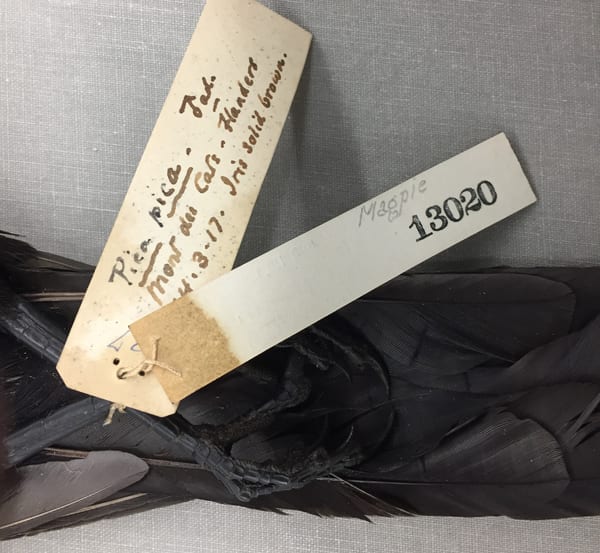[title: Science Moments] [subtitle: All About Owls]
[text: Where do you find owls in Canada?]
[text: Gregory Rand, Assistant Collections Manager, Zoology, Canadian Museum of Nature] Around the world, there’s about 250 owl species.
Here in Canada, we are lucky enough to have 16. Some species, such as the
Snowy Owl, are found in the Far North, where they are well adapted to the cold Arctic environment.
On the other hand, you will only find Barn Owls in the very south of Canada, as they are very poorly equipped to deal with our cold, harsh winters.
Habitat also plays a big role. The known range of the Spotted Owl in Canada is restricted to old-growth conifer forests on the West Coast.
In contrast, the Great Horned Owl is found from coast-to-coast in a variety of habitats, from boreal forest to urban parks.
[text: Are any owl species endangered?] Two out of the 16 owl species in Canada are listed as Endangered.
Spotted Owls and Barn Owls have always had very restricted ranges within Canada.
Barn Owl populations have been affected by habitat loss, changes in agricultural practices, uses of rodenticides and collisions with vehicles.
Spotted Owls have also been affected by habitat loss and fragmentation, as well as competition and hybridization
with the closely related Barred Owl, which moved in from the east side of the continent.
[text: Are all owls nocturnal?] Contrary to popular belief, not all owls are nocturnal.
One of the more striking features of owls are their large eyes.
These are superbly adapted to see in low-light conditions, which is when many of them are on the hunt.
But they can actually see quite well during the day and some species are very active during this time.
We just have to think about the Snowy Owl that breeds in the High Arctic, where it may be exposed to 24 hours of daylight.
Northern Hawk Owls—another northern owl species—will occasionally find themselves in the south,
where they are favourites of birdwatchers and photographers alike, in part due to their daytime activity.
[text: Where do owls nest?] Owls nest in a variety of locations, depending on the species:
in treetops, hollow trees, old bird nests, barns, and even on the ground.
They don’t make too much effort when building nests and will often use what is available to them.
Snowy Owls don’t have much of a choice. Way up in the Arctic, there are very few options other than building their nest directly on the ground.
Other species, such as the Great Grey Owl, will often reuse old nests from other species such as Northern Goshawks, Common Ravens or other large birds.
Northern Saw-whet Owls, screech-owls, Barred Owls, are cavity nesters
and they will build their nests in an old tree cavity—either a naturally forming one, or one built by a woodpecker.
The odd duck out is the Burrowing Owl. As the name implies, it builds its nest in a burrow.
Although they can actually dig their own burrow, they will generally use a pre-existing one
that was dug by a mammal such as a prairie dog or a ground squirrel.
More Videos from This Playlist
Amazing Adaptations of Owls
Owls have some amazing adaptations as predators. They see well in the dark, have acute hearing, and possess feathers for silent flight. They can even rotate their heads 270 degrees in either direction. Learn more in this Science Moment video, which is a complement to the museum exhibition Owls Rendez-Vous.
Still haven't subscribed to the Canadian Museum of Nature on YouTube? ►► https://bit.ly/3LBjIgw
Want to stay in the know? Follow the Canadian Museum of Nature on social media!
Facebook ►► https://bit.ly/2uIL53w
Instagram ►► https://bit.ly/3yItSZP
Twitter ►► https://bit.ly/3wpqhhI
LinkedIn ►► https://bit.ly/3wsOCmF
Canadian Museum of Nature— https://nature.ca
Hooo-hooo... Cool Facts about Owls in Canada
Around the world there are about 250 owl species—16 of them in Canada. The Great Horned Owl is found from coast to coast in a variety of habitats, from boreal forests to urban parks. Some species, such as Spotted Owls and Barn Owls, are affected by habitat loss. Discover these and other interesting facts in this Science Moment video, which is a complement to the museum exhibition Owls Rendez-Vous.
Still haven't subscribed to the Canadian Museum of Nature on YouTube? ►► https://bit.ly/3LBjIgw
Want to stay in the know? Follow the Canadian Museum of Nature on social media!
Facebook ►► https://bit.ly/2uIL53w
Instagram ►► https://bit.ly/3yItSZP
Twitter ►► https://bit.ly/3wpqhhI
LinkedIn ►► https://bit.ly/3wsOCmF
Canadian Museum of Nature— https://nature.ca








